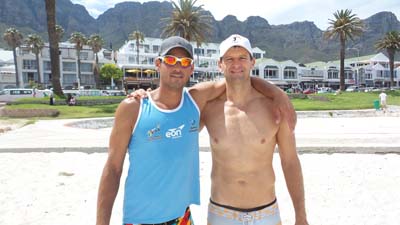
Andor Gyulai and New Partner Leslie Naidoo – Week 1
So for those of you that don’t know I have moved to South Africa for the next four months with the goal of playing in the South Africa FIVB event this December and maybe playing in several FIVB events in 2015 with the ultimate goal of playing in the Olympics in 2016. As you can imagine it’s a big ambitious goal considering I’m turning 39 and I was 30 pounds overweight just 2 years ago and barely playing any volleyball. But fortunately I am quickly moving in the right direction and I feel I am easily one of the top 2 or 3 teams in South Africa currently.
So with all of this in mind and having only started training with my new partner 8 days ago, every day I ask the question: “What is the most important points to focus on today so that we can have success together on the beach volleyball court?”
Now keep in mind this is my opinion, and I have not specifically asked any of the top coaches I have worked with over the last two years running and filming for Volleyball1on1.com, but I think I am on the right track and as always I am interested in your thoughts and feedback so let me know what you think?
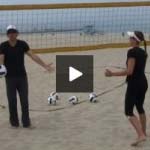 Day 1 – Spacing Concepts and Circle of Trust
Day 1 – Spacing Concepts and Circle of Trust
So I started our practice with Stein Metzger’s spacing concepts and circle of trust. Stein is one of the best coaches I have ever worked with on the beach and I was fortunate to witness him train the top Israeli Beach Team, plus film videos with him on various topics. In beach volleyball spacing is critical applies to sideout / offense, defense and transition. What I found was most people in South Africa use the court to determine the spacing vs. the ball and the conditions.
What I mean by this is the passer will pass the ball to the middle of the court no matter where they are and then try and run an outside set. Stein concepts are more about keeping the ball in the middle of the two players and hopefully always moving forward or up and also ensuring there is enough space between the two players so that there is a large enough circle to play the ball in.
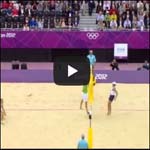 Day 2 – L vs I Offense, Passing the Ball Forward, and Running an Up and Down Set
Day 2 – L vs I Offense, Passing the Ball Forward, and Running an Up and Down Set
So one of the best coaches I have ever worked with is Eduardo “Anjinho” Bacil. Anjinho played with the best and he always talks about Scott Ayakatubby. Ack would pass the ball low and straight in front of him to set up his offense and Anjinho would have to run all the way across the court to set him. The point is you pass to set up your offense and not to set up your setter.
Ack would then want the ball set straight up and down so that he had maximum vision on the ball plus he had the opportunity to because he ran his offense from the outside, to get the larges angles and areas for hitting his power shots.
Anjinho point is the player sets up the offense he chooses or he run his offense based upon the serve. Now for me I like run the offense based upon the serve. What this means is if I or my partner is served down the line, you pass the ball straight in front of your inside leg. Your partner is automatically moving with you already because of the circle of trust and then they come in and ideally set an up and down set to the outside.
Now if the other team serves middle, the player that passes, passes middle, his partner is moving away towards their line on serve thereby creating space if needed for the circle of trust, the setter then comes in and sets and up and down set in the middle.
Now I have tried to show some videos on this concept. Here is a Video I did on the topic…
I currently have over 100 videos I filmed with Anjinho that I still need to add to volleyball1on1 on the topic.
 Day 2 Continued – Setting – Shoulders Square to Your Target
Day 2 Continued – Setting – Shoulders Square to Your Target
The next problem we started working on heavily was squaring our shoulders to your target. This is something that was really brought home to me when I filmed Sinjin Smith and Stein Metzger. Two of the best beach setters in the world and interestingly both brought it up for different reasons. Sinjin Smith – “You square your shoulders so your partner knows where you are setting.” Stein Metzger – “By facing your target it makes it easy to direct the ball where you want it to go.”
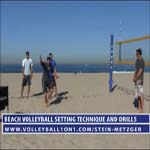 Again I found this as a common theme with most of the players in South Africa. Players were running to the middle of the court like indoor and then setting the ball over their inside shoulder. The result is a ball that does not go up and down which means it is more difficult to hit. But also it is really tough for your partner to know where the set is going.
Again I found this as a common theme with most of the players in South Africa. Players were running to the middle of the court like indoor and then setting the ball over their inside shoulder. The result is a ball that does not go up and down which means it is more difficult to hit. But also it is really tough for your partner to know where the set is going.
Day 3 – Game Plan Offense and Game plan Defense
This term “Game Plan Offense and Game Plan Defense” is a term I picked up from Bill Ferguson (2 Time NCAA Coach of Year) and I use it to refer to some concepts I learned from Anjinho, Stein and Steve Anderson (Gold Medal Beach Coach / Head Coach of Beach Volleyball Canada).
The idea is that where possible you want to run the offense or defense of your choosing. For me and my partner, based upon the serve we are trying to run our offense through the middle or from the outside. Once it is decided if we are attacking from the outside or middle there are certain things we need to establish with our hitting / offense and defense.
Offense with an outside set – The majority of the time players will block line and the defense will sit angle deep. Given this the first place I want to establish is a hard hit between 60-80% in front of the defender in the angle. This is one of the largest angles on the court (Going line to line angle) which means you have allot of space. What this does is it also forces your opponents to move forward on defense from the deep angle to the shorter or narrow angle in front of where they were playing defense before. Also this completely eliminates the block and what they are doing up in front of you on the line.
Once you establish this shot your deep line shot as well as your hard hit deep seam and hard hit deep angle will open up. The defender is now off balance and you are running a “Game Plan Offense”
This tactic is the same of for both the left and right side except that on the right side you need to chop the ball more than on the left side as a right handed hitter because of the smaller surface area when contacting the ball. Here is a great demo video of Sean Rosenthal Cut Shot! This shot needs to be used where ever possible to have real success as a right handed right side player.
Offense with a middle set – The offense from the middle set is a completely different game than that of the outside. The person who has explained it best for me so far was Steve Anderson, current head coach of beach volleyball Canada and Gold Medal Coach for the Women’s 2000 Olympic Beach Team.
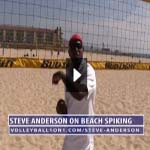 Here is a great video with Steve Anderson explaining Beach offense / spiking from the middle and outside.
Here is a great video with Steve Anderson explaining Beach offense / spiking from the middle and outside.
For the middle offense, the idea is you play the 4 meter game with the defender. The defenders court is 8 meters by 8 meters. Divide their court in half from the service line to the net and you create an imaginary 4 meter line. Now based upon where the defender is you will run your offense.
If the defender is behind the 4 meter line you run your offense through the middle and you chop or cut short. Short line, short angle. Also you hit short, short line, short angle.
If the defender is in front of the 4 meter line you hit over the block opposite to the defender or you hit them with the head chopper. This is can be extremely successful and is best used by player that play allot of beach and who have great court vision. Casey Patterson is one of the best I have ever seen do this through the middle. Emanuel Rego is one of the best I have seen run this game plan offense from the outside.
Here is a video I filmed on the subject of running beach offense through the middle and from the outside. This video also applies to the next segment game plan defense.
Game Plan Defense – Game plan defense means that we are setting up the opposite team to play into our strengths and run their offense into the areas we want to force them too. This begins by telling your partner where to serve.
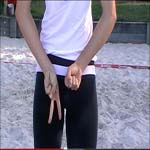 Here is a series of beach volleyball hand signals that Steve Anderson uses to show where to serve as well as the block. It is great to use when setting up your game plan defense. Also in the video series above I show some examples how Kerri Walsh Jennings and April Ross do the same thing when they play.
Here is a series of beach volleyball hand signals that Steve Anderson uses to show where to serve as well as the block. It is great to use when setting up your game plan defense. Also in the video series above I show some examples how Kerri Walsh Jennings and April Ross do the same thing when they play.
The main points are to if the player likes to hit from the outside, serve them middle and make them move all the way around to get outside. (Randy Stoklos was the best at this and did it in such a way that it was difficult to see the block and defense!!!) If they like to run middle serve their lines. Also play into your strengths on defense, meaning what do you like to block and play so that they run that play. What are they good at hitting and make them do something else.
Day 4 – Passing Forward and Running an Up and Down Set. Attacking Sharp Angle in Front of the Defender.
This was a repeat of day two / three and it is important to understand how difficult it is to change players that is used to passing middle and running outside. Also as we continued to work on our sideout / offense it was important to teach Leslie about having a strategy on his attack.
What was he establishing for the defense or defender? (Sharp angle and cut)
Once that was established what did he have as open because the defender now had to respect / move to cover that shot?
Day 5 – Rest and Andor Catching up on Volleyball1on1.com
Day 6 – Teach Andor 10 Blocking Calls and Playing Defense Around This.
This day we started really getting deeper into my 10 blocking calls I like to run on defense. Yes 10, I know but to be honest 5 most of you already know so to add 5 new calls should not be such a big deal.
Now I will try and film a video about this in the next two weeks, my calls are:
Line – Blocker line, defender angle.
Cross – Blocker angle, defender line, note the defender moves to the line and starts middle or angle.
Three – Blocker fakes angle and jumps into the line, defender neutral middle or stays angle or moves angle to line.
Four – Blocker fakes line and dives angle. The defender starts in the Angle and runs the line with the hit.
Five – Ball block by the blocker where the blocker is starting middle and defender is playing behind the block middle.
Seam – Blocker is blocking line / seam. The sharper the angle of approach of the hitter the more the defender goes cut shot. The straighter the approach of the attacker the more the defender is playing line defense.
Hang Ten – Ball Block with the blocker starting line, defender angle.
Line and Pinkie (Double Line) – Blocker line and makes and early obvious move line, defender is waiting sharp angle with hips open to run the line shot.
Angle and Pinkie (Double Angle) – The blocker starts neutral middle and blocks angle. The defender starts and stays line. Importantly the defender has hips open if needed and is ready for the deep angle ball over the blocker and the blocker is responsible for the cut shot.
Bic – Blocker is starting middle and diving to take ball or angle. The defender is starting shallow angle. As the ball is hit the defender runs and chases down the short line shot.
Teaching all of this was a challenge and the toughest part was focusing on myself not what the blocker was doing. Also during this session I was working heavily on the Stretch Step Shortening Cycle for Defense. The toughest part about this is not guessing and only moving once you have a clear indication of where the player is attacking.
We shot some great videos from a practice with Jason Lockhead and he was sharing his ideas on defense and how important it is not to lean or guess when defending but rather to just stand and wait.
Day 6 (Continued…) – Leslie Hitting on Two as the Left Side Player, Two Ball Offense
On day 6 we also spent about 30 minutes working on Leslie hitting on two as well as when and how we should run a two ball offense. Both Leslie and I are over 6 Foot 5 and are both big attackers so hitting on two is a valuable strategy to help your partner.
Some of the important points covered included:
Don’t aim for the line, rather aim for a foot or two in the line.
Use this shot when the wind is in your favor.
High contact point during the attack.
What angles can the left side, right handed player hit on two vs. what angles can a right handed right side player hit on two.
Day 7 – Rest
Day 8 – We Played Games
On Sunday day 8 we played games. It was remarkable for me how quickly we were able to implement these strategies and have success. The results were we beat the #1 team in South Africa 2 out of 3 games with us trying stuff in the third game when we lost. During and after the game a few new things became obvious.
1) Leslie was trying too much on this block and was not using correct footwork to block or pull. (I will try and add videos of this in the next few weeks)
2) Leslie was not “Reading the Game” his eyes were not focusing on the correct stuff!
(Here is a quick video I did showing both of these Volleyball Blocking Problems.) I will try do some instructional videos on the subject in the next few weeks!
3) Also on sets that were a little off he was not taking an area.
4) Leslie again was having problems facing his target when setting
5) I (Andor Gyulai) was in the later games jumping and guessing on defense. So I was guessing in the split step which is really bad and as a result missing easy balls.
6) Serving matters. Our serving was not tough enough. We still won but this had to be a greater focus.
7) Leslie calling the open court for the attack. The communication on transition and when Andor was spiking was too little and needed work.
8) I (Andor Gyulai) was not establishing my cut or sharp angle shot enough. Also when the opponents ran a “Four” defense I was not hitting out of it effectively.
So for all you coaches and players reading this, I want to thanks you for reading this the whole way and going through this with me. I pride myself on always being open to learn and hear others opinions. If you have thoughts on what I have said or things you think we should added please let me know below on our blog, forum or social media post.
Also keep in mind it takes allot of effort, time and confidence to openly share / write this post. Also I want to thank my incredible partner Leslie Naidoo for taking this journey with me openly and being so ready to learn and listen! Every day I try to adopt and learn these incredible qualities from him. Also I want to thank the incredible coaches that have helped me along the way. There are too many to mention but I must mention some of the more important ones: Anjinho, Stein, Steve Anderson and Gary Sato, THANKS!!!

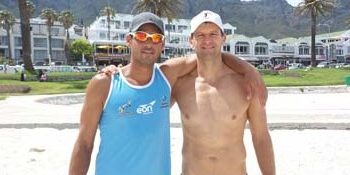






Hey Andor!
I watched your videos 4 years ago when I was first getting really interested in Volleyball, and I just recently became a member again. I just wanted to say thanks for making this site and for sharing a bunch of great tips for VB. I love the tutorial videos that let me hear from some of the best players including my idol – Logan Tom!
I think it’s awesome that you are trying to play in the 2016 Olympics. I wish you the best of luck, and know that I’ll be rooting for you! If you have recordings for your games or tournaments please link them on this site. I’d love to watch some good volleyball.
-Frank W.
Frank, thanks for the kind words! I really appreciate comments like your and it helps motivate me to always focus on KAIZEN – Contant never ending improvement! Feel free to also connect on Facebook and let me know if there is ever anything volleyball I can help with!
– Andor Gyulai (Owner – Volleyball1on1)